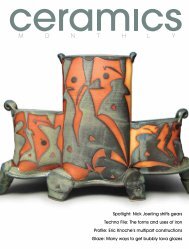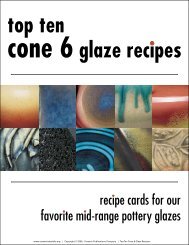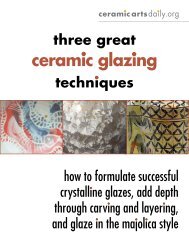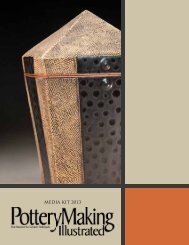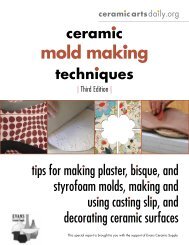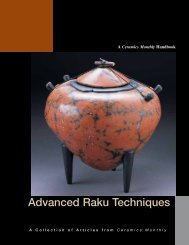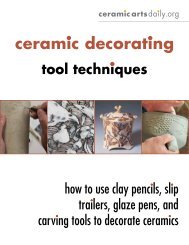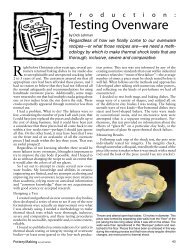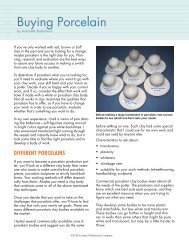Floating Clay - Ceramic Arts Daily
Floating Clay - Ceramic Arts Daily
Floating Clay - Ceramic Arts Daily
Create successful ePaper yourself
Turn your PDF publications into a flip-book with our unique Google optimized e-Paper software.
Frogs, lily pads and flowers, to 8 inches (20 centimeters) in diameter, handbuilt, colored <strong>Floating</strong> <strong>Clay</strong>, fired to Cone 8.<br />
<strong>Floating</strong> <strong>Clay</strong><br />
by Randolph Sill<br />
I was studying ceramics recently in Shigaraki, Japan, a mountain<br />
pottery village about two hours from Kyoto. While learning methods<br />
of contemporary ceramic sculpture, as well as traditional<br />
Japanese pottery techniques, I conceived of a ceramic sculpture<br />
that would be installed in the ponds of Togeinomori, the Shigaraki<br />
<strong>Ceramic</strong> Cultural Park, on the outskirts of town. I wanted to<br />
make the sculpture float on water, an endeavor doomed to be<br />
difficult. Wouldn’t it be cool, though, to have the sculpture meander<br />
around the ponds and go wherever the winds directed? Pedestals<br />
can be so confining!<br />
I initially imagined using slabs to create sealed forms that<br />
could float on the surface of the water. I would leave a small hole,<br />
through which expanding air could escape during the firing, and<br />
then plug it with wax or silicone after firing. Although this<br />
technique seemed feasible on paper, I imagined it would be quite<br />
difficult for the large scale I intended. My second inclination was<br />
<strong>Ceramic</strong>s Monthly February 2004<br />
58<br />
The cross-section of a piece of fired <strong>Floating</strong> <strong>Clay</strong> shows the<br />
bubbles that are trapped when silicon carbide turns to gas.
to use slabs again, but make a five-sided<br />
“cap” that would be inverted on the surface<br />
of the water and trap air underneath. For<br />
insurance, I could float the cap with buoyant<br />
materials like foam blocks or inflated<br />
inner tubes: not an elegant or enduring<br />
solution. I might have tried it, and it might<br />
have worked, had I not heard the legend of<br />
the mysterious floating clay.<br />
In Japan, the government supports their<br />
ceramists to such a degree that it builds and<br />
operates glaze- and clay-testing facilities in<br />
each prefecture. According to the story, back<br />
in the 1960s, government ceramics scientists<br />
were experimenting with various additives<br />
for clay and accidentally discovered<br />
that it was possible to make clay float. Recently,<br />
a scientist at the Shigaraki facility<br />
had reopened the file on this baffling paradox<br />
and had been performing experiments<br />
in the hope of finding a viable commercial<br />
application. A minuscule amount of silicon carbide is added to a<br />
uniquely composed clay body. The silicon carbide turns into a gas<br />
during the firing, which is encapsulated within the clay in the<br />
form of bubbles. Each bubble is completely sealed so the gas can’t<br />
escape and no water can permeate the clay.<br />
The final product is confounding. It is deceptively light and<br />
has a waferlike consistency. It is lighter than soft kiln brick or<br />
pumice. When cut or broken, the interior reveals the gaseous<br />
bubbles and looks like baked bread.<br />
Alas, floating clay is challenging to work with. Even with<br />
adding methyl cellulose and toilet-paper pulp, the clay body is<br />
short and has very little elasticity. Despite this drawback, it is not<br />
necessary to slip and score when working with floating clay, as the<br />
parts will fuse together while firing. You can make fairly thick<br />
objects as well. If the silicon carbide is not evenly mixed into the<br />
clay, uneven distortion can occur. If the clay is well mixed, the<br />
final product will “rise” in the kiln and expand in a uniform<br />
fashion, but it is not particularly strong or resistant to wear. On<br />
the other hand, it doesn’t retain heat, it won’t crack when frozen<br />
and it floats on water!<br />
Mixing <strong>Floating</strong> <strong>Clay</strong><br />
One of the greatest challenges I encountered was in getting the<br />
active ingredient, silicon carbide (SiC), evenly distributed through-<br />
The Shigaraki <strong>Ceramic</strong> Cultural Park provides space for artists, as well as research and exhibition facilities.<br />
<strong>Ceramic</strong>s Monthly February 2004<br />
59<br />
out the clay body. This is partly due to the fact that the SiC<br />
comprises only 0.5% of the total dry weight of the clay body. I<br />
mixed the clay by first mixing all dry ingredients together, minus<br />
the SiC. Then I took 10% of the dry-mixed ingredients and<br />
added the SiC. This was shaken vigorously in a plastic bag for a<br />
few minutes, then ball milled for approximately 20 minutes.<br />
Next, I added more dry ingredients (about 40% total weight) and<br />
placed that in a dough mixer for 20 minutes. Because the clay is<br />
composed of 25% water, I added all of the water to only 40% of<br />
the dry ingredients, made a slurry in the dough mixer and let it<br />
mix for 10 minutes. I then added in the remaining dry ingredients<br />
and mixed thoroughly.<br />
Forming<br />
Because of the absurdly high feldspar content, <strong>Floating</strong> <strong>Clay</strong> is<br />
very short. It has almost no elasticity and is difficult to dry<br />
without cracking. I remedied this problem somewhat by adding<br />
one or more of the following ingredients: methyl cellulose (a<br />
weak, nontoxic adhesive), Biopoly (an organic additive), and<br />
toilet-paper pulp for strength (one roll of toilet paper for every 10<br />
kilograms of wet clay).<br />
<strong>Floating</strong> <strong>Clay</strong> can be thrown, but the forms I threw slumped a<br />
lot in the kiln. Perhaps decreasing the silicon carbide, or firing to<br />
a slightly cooler temperature, might have helped. Give it a try!<br />
PHOTOS: SHINJI OTANI
Finished sculptures made of colored <strong>Floating</strong> <strong>Clay</strong>, fired to Cone 8,<br />
by Randolph Sill, Seattle, Washington.<br />
Firing<br />
This is important. Protect your kiln in the following two<br />
ways: First, recognize that floating clay distorts and expands in<br />
the kiln. Leave a lot of extra space around your pieces. I can’t<br />
tell you how much they will rise, as that depends on the total<br />
quantity of clay that is fired. For example, a 6-inch-diameter,<br />
1-inch-tall cookie may only grow to be 7 inches in diameter. A<br />
6-inch-diameter, 4-inch-tall cookie may end up growing to 9<br />
inches in diameter.<br />
Second, coat the kiln shelves with a thick layer of alumina<br />
hydrate in powder form as well as kiln wash. Sift it right onto<br />
the shelf. It should be about ⅛ inch thick. This will not only<br />
prevent the clay from sticking to the shelves, it will allow the<br />
clay to grow horizontally with as little friction against the kiln<br />
shelf as possible. Don’t skimp on the alumina hydrate, as you<br />
can reuse it in subsequent firings.<br />
If you have any breakthrough discoveries, or if you need<br />
more recipes or information, please contact Randolph Sill<br />
through www.madpotter.com.<br />
<strong>Ceramic</strong>s Monthly February 2004<br />
60<br />
recipes<br />
White <strong>Floating</strong> <strong>Clay</strong> Base<br />
(Cone 8)<br />
Hata Feldspar .................................. 80.0 %<br />
Motoyama <strong>Clay</strong> ............................... 10.0<br />
New Zealand Kaolin ........................ 10.0<br />
100.0 %<br />
Add: Methyl Cellulose ..................... 1.0%<br />
Silicon Carbide ........................ 0.5 %<br />
This base recipe has low distortion, but is less<br />
buoyant than the pink base.<br />
Pink <strong>Floating</strong> <strong>Clay</strong> Base<br />
(Cone 8)<br />
Hata Feldspar .................................. 50.0 %<br />
Nissan Feldspar ............................... 30.0<br />
Bentonite ........................................ 5.0<br />
Motoyama <strong>Clay</strong> ............................... 10.0<br />
New Zealand Kaolin ........................ 5.0<br />
100.0 %<br />
Add: Methyl Cellulose ..................... 1.0%<br />
Silicon Carbide ........................ 0.5 %<br />
The pink color of this base is a bit muted. It<br />
has more distortion upon firing and, as a<br />
result, is more buoyant than the white base.<br />
Substitutions for Motoyama clay should contain<br />
less than 20% sand.<br />
Colorants for <strong>Floating</strong> <strong>Clay</strong><br />
Royal Blue<br />
Cobalt Oxide ....................... 0.5–1.0 %<br />
Brilliant Blue<br />
Blue Mason Stain ...................... 3.0%<br />
Bright Yellow<br />
Vanadium Oxide ....................... 3.0%<br />
Light Green<br />
Vanadium Oxide ....................... 3.0%<br />
Chrome Oxide .......................... 0.5%<br />
Dark Green<br />
Chrome Oxide .................... 0.5–1.0 %<br />
Mint Green<br />
Copper Carbonate .................... 1.0%<br />
Percentages based on weight of wet clay.<br />
Other colors can be tested using stains at 3%<br />
as a starting point.<br />
Hata Feldspar<br />
K2O ................................................... 30%<br />
Na2O ................................................. 50<br />
SiO2 ................................................... 20<br />
100 %<br />
Nissan 7 Feldspar<br />
K2O ................................................... 30%<br />
Na2O ................................................. 30<br />
SiO2 ................................................... 39<br />
Fe O ................................................. 1<br />
2 3<br />
100 %



